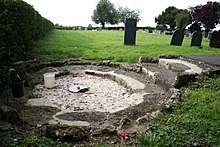Gilbert of Sempringham
Gilbert of Sempringham, CRSA (c. 1085 – 4 February 1190),[1] the founder of the Gilbertine Order, was the only Englishman to found a conventual order, mainly because the Abbot of Cîteaux declined his request to assist him in organising a group of women who wanted to live as nuns, living with lay brothers and sisters, in 1148.[2] In the end he founded a double monastery of canons regular and nuns.
Saint Gilbert of Sempringham | |
|---|---|
| Priest and religious founder | |
| Born | ca. 1085 Sempringham, Lincolnshire, Kingdom of England |
| Died | 4 February 1189 or 1190 Sempringham, Lincolnshire, Kingdom of England (Aged 104 or 105) |
| Venerated in | Roman Catholic Church (Canons Regular of St Augustine), Church of England |
| Canonized | 1202, Rome, Papal States by Pope Innocent III |
| Feast | 4 February |
Life
Gilbert was born at Sempringham, near Bourne in Lincolnshire, the son of Jocelin, an Anglo-Norman lord of the manor, who unusually for that period, actively prevented his son from becoming a knight, instead sending him to the University of Paris to study theology. Some physical deformity may have made him unfit for military service, making an ecclesiastical career the best option. When he returned in 1120 he became a clerk in the household of Robert Bloet, Bishop of Lincoln, started a school for boys and girls (the existing primary school at Pointon is still named after him) and was ordained by Robert's successor, Alexander.[3] Offered the archdeaconry of Lincoln, he refused, saying that he knew no surer way to perdition.
A man from Stamford had lived a long time with his wife without having children. It happened that Father Gilbert stopped at their house to spend the night. The discreet lady of the household put her trust in the holiness of the guest she had received, and prepared a place for him on her own couch so that through his merits she might be found worthy to bear a son, as the Shunammite did through Elisha. It turned out just as she believed. For when her husband came home to sleep he before long fathered a son on her, and they named him after Father Gilbert. When Our Lord's servant heard what had happened, being a cheerful and generous person he sent the boy a cow to supply him with food, acting just as if the boy had been his own son.
— The Book of St. Gilbert [4]
The Gilbertines

When Gilbert's father died in 1130 he became lord of the manor of Sempringham. In 1131 he founded the Gilbertine Order, and constructed at Sempringham, with the help of Alexander, a dwelling and cloister for nuns, at the north of the church of St Andrew.[3] Eventually he had a chain of twenty-six convents, monasteries and missions. A custom developed in the houses of the order called "the plate of the Lord Jesus", whereby the best portions of the dinner were put on a special plate and shared with the poor.[5] In 1148 he approached the Cistercians for help. They refused because he included women in his order. The male part of the order consisted of Canons Regular.
In 1165 Gilbert was charged with having aided Thomas Becket when Thomas had fled from King Henry II after the council of Northampton, but he was eventually found innocent.[3] In 1174 some of his lay brothers revolted, but he received the backing of Pope Alexander III. Gilbert resigned his office late in life because of blindness and died at Sempringham in about 1190, at the claimed age of 106.[6]
The only religious order of English origin founded during the Middle Ages, continued to thrive, but came to an end when King Henry VIII suppressed all Catholic monasteries.[5]
Veneration

Gilbert was canonised in 1202 by Pope Innocent III. His liturgical feast day is on 4 February, commemorating his death. According to the order of Hubert Walter, the bishops of England celebrated his feast, and his name was added to the wall of the church of the Four Crowned Martyrs. His Order did not outlast the Reformation, however; and despite being influenced by Continental models, it did not maintain a foothold in Europe.[7]
Legacy
There are at least three primary schools in the UK named after him.[8]
References
- Iredale (pp. 7, 54) says 1189 but this is probably according to the Old Style calendar, which began the year on Lady Day, in March. By the time England abandoned this, the discrepancies of the Julian calendar had moved it into April by modern reckoning.
- Iredale places this in 1147 (p. 4). Again, the difference between Old and New style calendars may account for this.
- Butler, Richard Urban. "St. Gilbert of Sempringham." The Catholic Encyclopedia. Vol. 6. New York: Robert Appleton Company, 1909. 12 Oct. 2014
- Gilbert, Saint (1987). Foreville, Raymonde; Keir, Gillian (eds.). The Book of St Gilbert. Clarendon Press. pp. 112–115. ISBN 9780198222606.
- Foley O.F.M., Leonard. "St. Gilbert of Sempringham", Saint of the Day, Lives, Lessons and Feast, (revised by Pat McCloskey O.F.M.), Franciscan Media
- Graham, Rose S. Gilbert of Sempringham and the Gilbertines: a history of the only English monastic order (London: Elliott Stock, 1903)
- Farmer, David Hugh (1997). The Oxford dictionary of saints (4th ed.). Oxford [u.a.]: Oxford Univ. Press. pp. 209–210. ISBN 9780192800589.
- http://www.stgilberts.co.uk; http://www.stgilbertsrc.co.uk; http://www.stgilbertspointon.co.uk
Further reading
- Iredale, Eric W., Sempringham and Saint Gilbert and the Gilbertines. (1992. ISBN 0-9519662-0-0. (Includes Capgrave, John, The Life of St Gilbert.)
- Müller, Anne, "Entcharismatisierung als Geltungsgrund? Gilbert von Sempringham und der frühe Gilbertinerorden," in Giancarlo Andenna / Mirko Breitenstein / Gert Melville (eds.), Charisma und religiöse Gemeinschaften im Mittelalter. Akten des 3. Internationalen Kongresses des "Italienisch-deutschen Zentrums für Vergleichende Ordensgeschichte" (Münster u.a., LIT, 2005) (Vita regularis. Ordnungen und Deutungen religiosen Lebens im Mittelalter, 26), 151–172.
- . Encyclopædia Britannica (11th ed.). 1911.
- Thomas Andrew Archer (1890). . In Stephen, Leslie; Lee, Sidney (eds.). Dictionary of National Biography. 21. London: Smith, Elder & Co.
